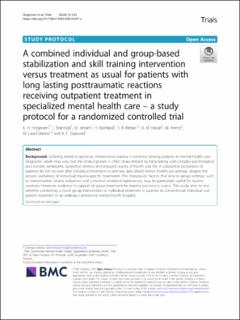| dc.contributor.author | Holgersen, Katrine Høyer | |
| dc.contributor.author | Brønstad, Ingunn | |
| dc.contributor.author | Jensen, Marianne | |
| dc.contributor.author | Brattland, Heidi | |
| dc.contributor.author | Reitan, Solveig Merete Klæbo | |
| dc.contributor.author | Hassel, Anne Marit | |
| dc.contributor.author | Arentz, Marianne | |
| dc.contributor.author | Lara Cabrera, Mariela Loreto | |
| dc.contributor.author | Skjervold, Anne Elisabeth | |
| dc.date.accessioned | 2021-03-19T13:20:06Z | |
| dc.date.available | 2021-03-19T13:20:06Z | |
| dc.date.created | 2020-07-27T15:06:38Z | |
| dc.date.issued | 2020 | |
| dc.identifier.citation | Trials. 2020, 21 (1), . | en_US |
| dc.identifier.issn | 1745-6215 | |
| dc.identifier.uri | https://hdl.handle.net/11250/2734517 | |
| dc.description.abstract | Background
Suffering linked to previous interpersonal trauma is common among patients in mental health care. Diagnostic labels may vary, but the clinical picture is often characterized by long-lasting and complex psychological and somatic symptoms, subjective distress and reduced quality of health and life. A substantial proportion of patients do not recover after individual treatment in ordinary specialized mental healthcare settings, despite the proven usefulness of individual trauma-specific treatments. The therapeutic factors that arise in group settings, such as normalization, shame reduction and corrective relational experiences, may be particularly useful for trauma survivors. However, evidence in support of group treatment for trauma survivors is scarce. This study aims to test whether combining a novel group intervention to individual treatment is superior to conventional individual out-patient treatment in an ordinary community mental health hospital. Methods: In a single-site, non-blinded, randomized controlled trial (RCT), the effect of a combined group-based stabilization and skill-training (SST) intervention added to individual treatment will be compared to conventional treatment (treatment as usual, TAU) alone. Participants (N = 160) with ongoing and long-lasting reactions related to known adverse life events from the past will be recruited among patients at general outpatient clinics in a community mental health centre at St. Olav’s University Hospital, Trondheim, Norway. Following baseline assessment and randomization, participants will complete follow-up measures at 4, 8, 13 and 19 months post-baseline. The primary outcome is personal recovery (The questionnaire about the process of recovery , QPR). Secondary outcomes include (1) self-reported symptoms of posttraumatic stress, general mental and somatic health symptoms, well-being, functional impairment and client satisfaction, (2) immunological and endocrine response measured in blood samples and (3) national registry data on occupational status, use of mental health services and pharmacological treatment. Additionally, mechanisms of change via posttraumatic cognitions will be examined. Discussion: The addition of a group-based intervention to individual treatment for trauma survivors might prove to be an efficient way to meet the need of long-lasting high-intensity treatment in a large group of patients in mental health care, thereby reducing their suffering and increasing their psychosocial functioning. | en_US |
| dc.language.iso | eng | en_US |
| dc.publisher | BMC | en_US |
| dc.rights | Navngivelse 4.0 Internasjonal | * |
| dc.rights.uri | http://creativecommons.org/licenses/by/4.0/deed.no | * |
| dc.title | A combined individual and group-based stabilization and skill training intervention versus treatment as usual for patients with long lasting posttraumatic reactions receiving outpatient treatment in specialized mental health care – a study protocol for a randomized controlled trial | en_US |
| dc.type | Peer reviewed | en_US |
| dc.type | Journal article | en_US |
| dc.description.version | publishedVersion | en_US |
| dc.source.pagenumber | 13 | en_US |
| dc.source.volume | 21 | en_US |
| dc.source.journal | Trials | en_US |
| dc.source.issue | 1 | en_US |
| dc.identifier.doi | 10.1186/s13063-020-04297-z | |
| dc.identifier.cristin | 1820649 | |
| dc.description.localcode | © The Author(s). 2020 Open Access This article is licensed under a Creative Commons Attribution 4.0 International License, which permits use, sharing, adaptation, distribution and reproduction in any medium or format, as long as you give appropriate credit to the original author(s) and the source, provide a link to the Creative Commons licence, and indicate if changes were made. The images or other third party material in this article are included in the article's Creative Commons licence, unless indicated otherwise in a credit line to the material. If material is not included in the article's Creative Commons licence and your intended use is not permitted by statutory regulation or exceeds the permitted use, you will need to obtain permission directly from the copyright holder. To view a copy of this licence, visit http://creativecommons.org/licenses/by/4.0/. The Creative Commons Public Domain Dedication waiver (http://creativecommons.org/publicdomain/zero/1.0/) applies to the data made available in this article, unless otherwise stated in a credit line to the data. | en_US |
| cristin.ispublished | true | |
| cristin.fulltext | original | |
| cristin.qualitycode | 1 | |

